Why 2020 has been good for England's beavers
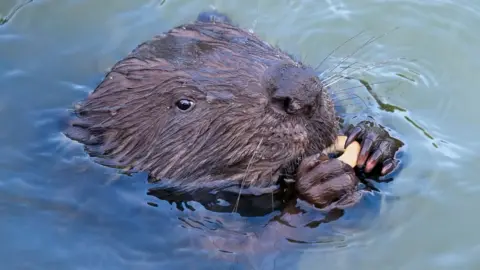 Getty Images
Getty ImagesA lot has happened in 2020, but one thing that might have been overlooked is the re-emergence of the beaver in England. A five-year government trial into the reintroduction of beavers into the wild ended, citing a long list of benefits, while new beaver homes have been set up in enclosures around the country. What's so good about the beaver - and why isn't everyone a fan?
Beavers have been dubbed the ultimate environmental engineers, capable of alleviating flooding and sparking new life into barren wildernesses.
They are perhaps most famous for their dams, and it is these that bring the ecological benefits according to the Beaver Trust, a campaign group that wants to see the rodents reintroduced "in the right places" in England.
With their rudder-shaped tails, webbed feet and goggle-like second eyelids, beavers work best in the water and they only really feel safe and secure in depths of at least 1m (3ft).
They gnaw down nearby trees with their incredibly tough orange teeth and collect other debris to dam up streams, creating ponds and pools behind to dwell in.
 David Parkyn
David ParkynThey also dig canals so they can forage for the foliage they liked to feed on, with the accumulating water creating wetlands for other species, such as frogs, dragonflies and fish to flourish in.
Their dams also slow water flow, relieving flooding problems further down stream while pooling water for droughts, according to Eva Bishop of the Beaver Trust.
"The right beaver in the right place can be amazing," she said.
"Beavers create a whole mosaic of diverse habitats and allow a flourishing bio-diversity and bio-abundance.
"They have a genuine macro-scale impact and they are a key part of our tool kit to rescue our wildlife.
"Beavers bring life."
 Eva Bishop
Eva BishopTo many of us, beavers seem like a foreign entity, more naturally suited to the wilds of North America.
But, until 400 or so years ago, they were native Englanders, before being hunted to extinction for their soft warm fur, meat and glandular oil for use in medicines.
In recent years they have been reintroduced in Scotland, Wales and now increasingly in England, with up to 500 thought to be housed around the country, mostly in enclosures.
In 2020, pairs of beavers have been released on the Holnicote Estate in Somerset, at Hatchmere near Delamere Forest in Cheshire, on the Lowther Estate in Cumbria and at Wild Ken Hill in Norfolk, with plans imminent to release a couple at Willington in Derbyshire
Allow Google YouTube content?
In Devon, beavers were given the right to remain and spread naturally on the River Otter by the Department of Food, Environment and Rural Affairs (Defra) after a five-year study concluded the benefits they bring outweigh the negatives.
Meanwhile, a pair of beavers released on the Spains Hall Estate near Braintree in Essex in 2019 have had kits.
And the beavers in Somerset have just built the first dam on Exmoor in 400 years.
Farmer Chris Jones, who recently appeared on the BBC's Cornwall with Simon Reeve, has enthusiastically welcomed beavers to his land.
The livestock rearer introduced two beavers into an enclosure around a stream at Woodland Valley Farm in 2017 and said they had started building their first dam within two nights.
They have since built a series of dams, creating what Mr Jones called "water terraces".
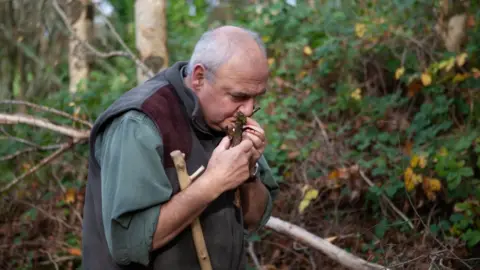 Nina Constable Media
Nina Constable Media Mr Jones said the nearby village of Ladock has a history of repeated flooding, but the beavers had helped to slow the flow from the stream on his farm.
"The water from here doesn't all end land up in one lump down at the river at Ladock, adding to all the lumps from the other tributaries and then causing a flood," Mr Jones said.
He also said the pools the beavers created had sparked an "orchestra of life", adding: "There is no species that does as much as this one."
Ms Bishop said we spend large sums on flood relief schemes that echo the work of beavers, such as building dams to slow streams and rivers and make them meander more.
"It's bonkers, really," she said, adding: "The beaver will do it for free and, crucially, maintain it."
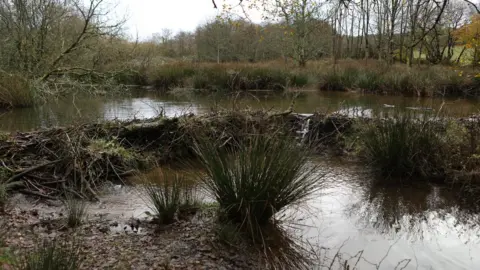 Beaver Trust/Nina Constable Media
Beaver Trust/Nina Constable Media Not everyone is a beaver fan, though. There are two chief concerns from farmers and anglers.
Some farmers fear beavers could chomp on their crops, damage trees and create localised flooding.
"Any species introduction can have a massive impact on the countryside and farming," said Phil Jarvis, National Farmers' Union (NFU) environment forum chairman.
"Beaver activity can undermine riverbanks and impede farmland drainage, making fields too waterlogged for cropping or grazing.
"This seriously hinders farmers' ability to produce food for the nation."
The NFU says it is assisting as Defra creates a "long-term management plan" which, the union said, must include "an effective exit strategy" should "any major issues occur".
 Beaver Trust/Nina Constable Media
Beaver Trust/Nina Constable Media Anglers fear the beavers' dams could make it much harder for the likes of North Atlantic salmon and sea trout, both of which are already struggling population-wise, to reach their breeding grounds.
The Angling Trust has commissioned an independent "full literature review" to see whether or not beavers have caused such issues elsewhere, which is due to be published imminently.
"We are not saying no [to beavers]," said Mark Owen, head of freshwater at the trust, adding: "We are saying we need to look at the possible impact in far more detail.
"The report may come out and say there is no reason for concern, but we need to look at it because the study of the impact on fish so far has been sparse."
Mr Owen said there were no rivers in England where salmon were "doing well" and it was becoming an endangered species.
He said with low fish numbers it was vital to get salmon to their spawning grounds "without delay" and any potential obstacle was a cause for concern.
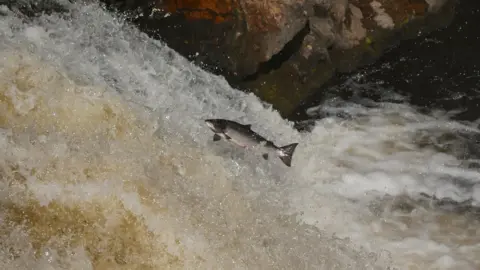 Getty Images
Getty ImagesThough such fish can leap over barriers, each attempt saps their energy.
"Where you have healthy numbers, a small number of fish not making it isn't really a problem," Mr Owen said.
"But where the numbers are already low, you need them all to get through."
Ms Bishop said she recognised the concerns of both farmers and anglers and accepted that a "beaver in the wrong place can be a disaster". But she said there were "easy and cheap" fixes, with lessons already learned from releases in Germany and Norway, as well as those in Wales and Scotland.
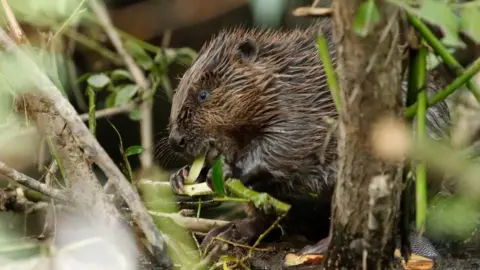 Joshua Harris
Joshua HarrisTrees, for example, can be coated with a sand mixture or surrounded by a metal mesh to deter the beavers from munching on them.
And a small buffer of unfarmed land between the beavers' habitats and farmers' fields could reduce any clashes.
A 5m (16ft) buffer scheme in Germany saw beaver-farmer conflicts reduce by 95%, Ms Bishop said.
As for fish, beaver dams normally create side rivulets that travelling salmon and trout can use, she said.
"In the wild there are no beaver-fish conflicts. Any issues are because of us and our management of the rivers," Ms Bishop said.
And ultimately beavers can be moved or, in the most extreme cases, culled under licence as is happening in Scotland.
A Defra spokesman said: "We are firmly committed to providing opportunities to reintroduce formerly native species, such as beavers, where the benefits for the environment, people and the economy are clear.
"But we also understand that there are implications for landowners, and we will take care to ensure that all potential impacts are carefully considered, and a consultation on our national approach and management will open early next year."
